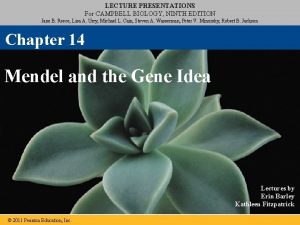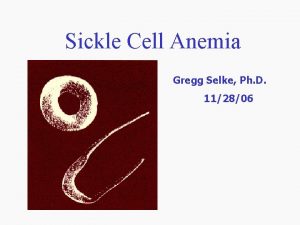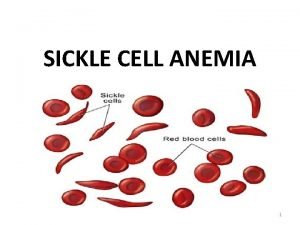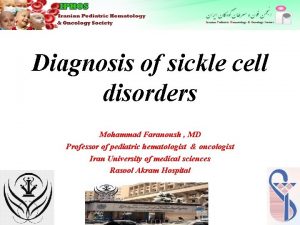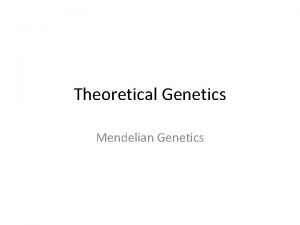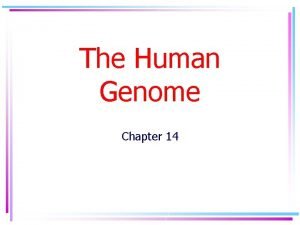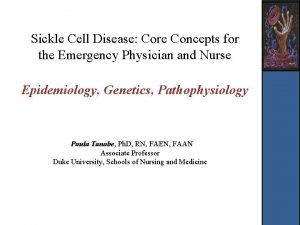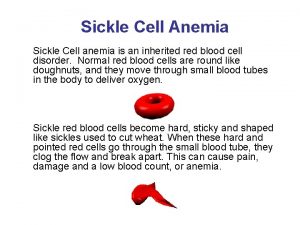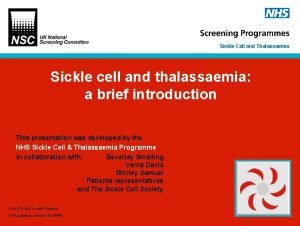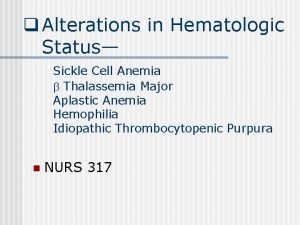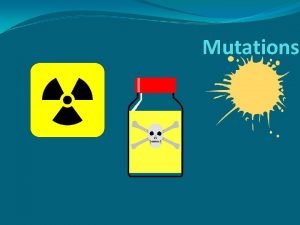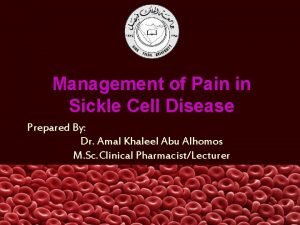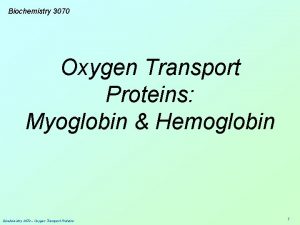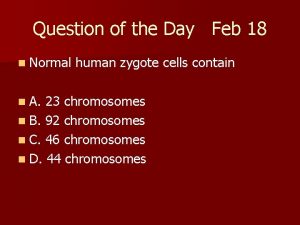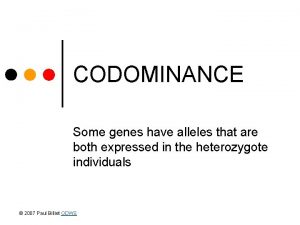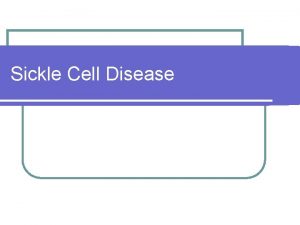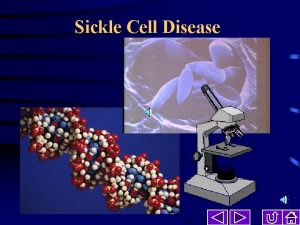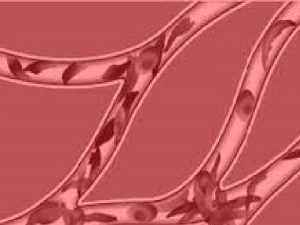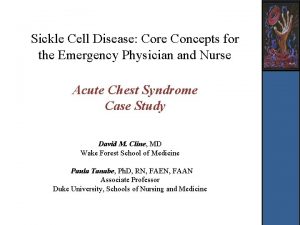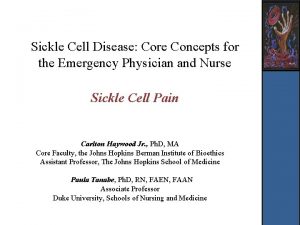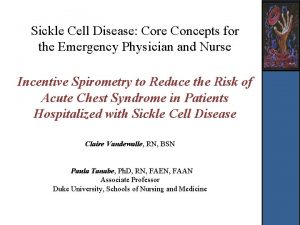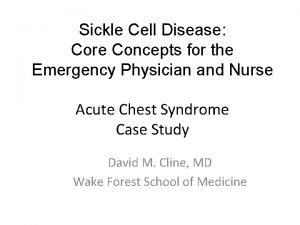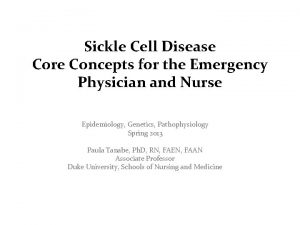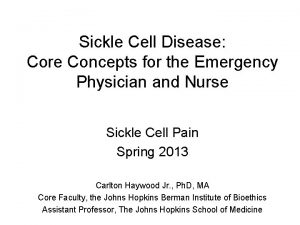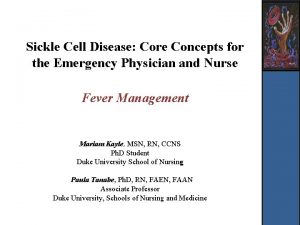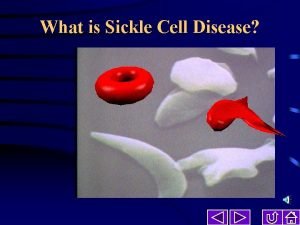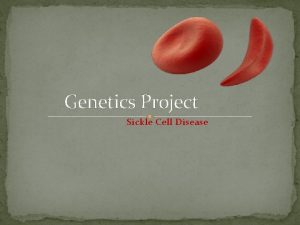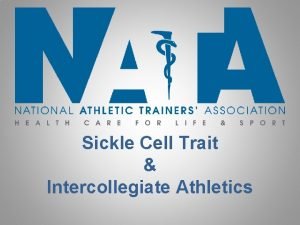Sickle Cell Disease Core Concepts for the Emergency


















- Slides: 18

Sickle Cell Disease: Core Concepts for the Emergency Physician and Nurse Acute Stroke Laura Moore, BS, RN Duke University School of Nursing Paula Tanabe, Ph. D, RN, FAEN, FAAN Associate Professor Duke University, Schools of Nursing and Medicine

Objectives • Identify epidemiologic and clinical risk factors for developing acute stroke in Sickle Cell Disease (SCD) • Review guidelines for treatment of acute stroke • Review treatment of acute stroke • Identify differences between children & adults with stroke & SCD

Pretest- Question 1 What is the frequency of overt stroke in children with sickle cell anemia (SS and SB 0), in the absence of primary stroke prevention? a. b. c. d. 20% 15% 10% 5%

Pretest- Question 2 A 22 year old male presents with an acute stroke confirmed by neuroimaging. Which one of these is the prominent treatment strategy: a. b. c. d. Thrombolytics Observation and heparin Exchange transfusion None of the above

Epidemiology • Stroke is one of the most common & devastating complications of SCD 1 • Strokes occur most commonly in patients with Hb. SS 2 • In the absence of stroke prevention, approximately 10% of children with SS genotype will have an overt stroke. The overall incidence & risk for the first stroke increases with age to 24% by age 45 2 • In the absence of stroke prevention, an additional 20 -35% of children with SS genotype will have a silent cerebral infarct

Causes of Stroke • Transient ischemic attack (TIA) often precedes stroke 1 • Overt stroke is generally secondary to stenosis or occlusion of the internal carotid or middle cerebral artery 1 • Strokes may be precipitated by Acute Chest Syndrome, parvovirus infection, or other acute anemic events 1

Risk Factors • History of transient ischemic attack, elevated systolic blood pressure, elevated steady state leukocyte count, severe anemia, & prior history of acute chest syndrome 2 • Ischemic stroke occurrence is more frequent in the pediatric patient population 2 • Hemorrhagic stroke occurrence is more frequent in the adult patient population 2

Assessment of SCD Stroke • Symptoms- Silent cerebral infarct – Subtle behavioral changes – Academic difficulties • Symptoms- Acute Stroke 2 – – – Prolonged headaches Aphasia Hemiparesis Seizures Gait disturbances

Clinical Scenario • https: //www. youtube. com/watch? v=5 YYJn. VG X_WQ&feature=youtu. be • Copy and paste this link into your browser.

Screening for Stroke Prevention in Children (SS, SB 0) Pediatric considerations • Trans-Cranial Doppler (TCD) is a non-invasive ultrasonographic technique used to measure velocities of the internal carotid or middle cerebral arteries 1 • TCD velocity is considered abnormal when the velocity is >200 cm/sec 1 • TCD ultrasonography is a recommended screening tool for CVA in children age 2 through 16 with SCD 1 • Children with abnormal TCD’s should be placed on a chronic transfusion program to prevent stroke, managed by a SCD expert

Treatment of Acute Stroke in SCD • Complete physical & neurological examination • Prompt brain imaging studies: – Computed tomography scan (CT) – Magnetic resonance imaging/magnetic resonance angiography (MRI/MRA) • In consultation with SCD expert & neurologist, & if high suspicion for stroke: – Make arrangements for simple or exchange transfusion, goal %S = 30% – Chronic transfusion should be initiated to prevent new strokes

Treatment for Acute Stroke in patient with SCD with Moyamoya 3 • Progressive stenosis of the terminal internal carotid arteries & their main branches causes a compensatory collateral network to develop at the base of the brain known as moya • Moyamoya is seen as a “puff of smoke” on catheter angiography • Cerebral revascularization may decrease the risk of recurrent stroke in patients with SCD with moya disease. • Patients with SCD should be referred if moya is seen on angiography.

NHLBI Recommendations for Acute Stroke in SCD 1 • In people with SCD who present with severe headache, altered level of consciousness, seizures, speech problems, &/or paralysis, evaluate for acute stroke by seeking neurologic consultation and performing an urgent head computerized tomography (CT) scan followed by magnetic resonance imaging (MRI) and magnetic resonance angiography (MRA) if available • In consultation with a sickle cell expert, perform exchange transfusion in people with SCD who develop acute stroke confirmed by neuroimaging

Pediatric Differences Pediatric considerations • Children ages 2 -16 years should be screened with transcanial doppler to identify high risk of stroke • Children with a TCD >200 cm/sec should be referred for chronic transfusion therapy • Children with declining function in school should be referred for neurocognitive evaluation

Posttest- Question 1 What is the frequency of overt stroke in children with sickle cell anemia (SS and SB 0), in the absence of primary stroke prevention? a. b. c. d. 20% 15% 10% 5%

Posttest- Question 2 A 22 year old male presents with an acute stroke confirmed by neuroimaging. Which one of these is the prominent treatment strategy: a. b. c. d. Thrombolytics Observation and heparin Exchange transfusion None of the above

Posttest Answers & Rationale • Question 1 – Answer : c) 10% – Rationale: In the absence of stroke prevention, approximately 10% of children with SS genotype will have an overt stroke. The overall incidence & risk for the first stroke increases with age to 24% by age 45 2. Please see slide 5 • Question 2 – Answer: c) Exchange transfusion – Rationale: the NHLBI recommendation recommend exchange transfusion for acute stroke confirmed by neuroimaging. Please see slide 14

References 1. 2. 3. National Heart, Lungs, And Blood Institute. (2014). Evidenced-based management of sickle cell disease. National Institute of Health. Retrieved fromhttp: //www. nhlbi. nih. gov/sites/www. nhlbi. nih. gov/files/sickle-cell-disease-report. pdf Pack-Mabien, A. (2014). A primary care provider’s guide to preventive and acute care management of adults and children with sickle cell disease. American Academy of Nurse Practitioners. doi: 10. 1111/j. 17457599. 2009. 00401. x Talahma, M. , Strbian, D. , & Sundararajan, S. (2014). Sickle cell disease and stroke. Stroke. doi: 10. 1161/STROKEAHA. 114. 005144
 Gene therapy for sickle cell disease
Gene therapy for sickle cell disease Incomplete vs codominance
Incomplete vs codominance Sickle cell anemia
Sickle cell anemia Sickle cell disease
Sickle cell disease Types of sickle cell disease
Types of sickle cell disease Sickle cell anemia genotype and phenotype
Sickle cell anemia genotype and phenotype Chapter 14 the human genome making karyotypes answer key
Chapter 14 the human genome making karyotypes answer key Life expectancy of sickle cell patients
Life expectancy of sickle cell patients Sickle cell hemoglobin structure
Sickle cell hemoglobin structure Difference between sickle cell anaemia and thalassemia
Difference between sickle cell anaemia and thalassemia Aplastic crisis
Aplastic crisis Tiki barber sickle cell
Tiki barber sickle cell 4 steps of protein synthesis
4 steps of protein synthesis Pethidine in sickle cell
Pethidine in sickle cell Sickle cell karyotype
Sickle cell karyotype Sickle cell pedigree
Sickle cell pedigree Sickle cell hemoglobin structure
Sickle cell hemoglobin structure Sickle cell punnett square
Sickle cell punnett square Is sickle cell anemia codominant
Is sickle cell anemia codominant
